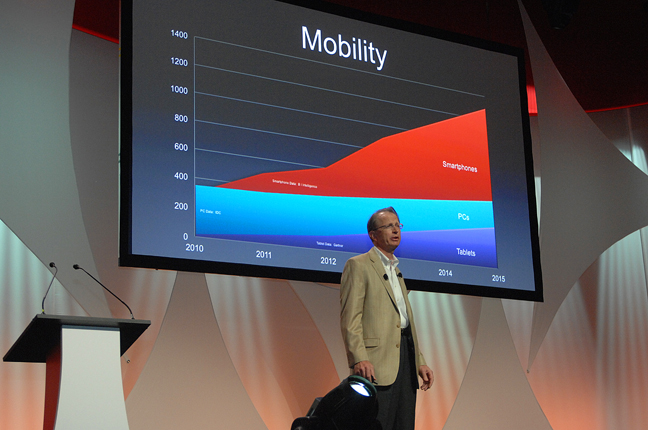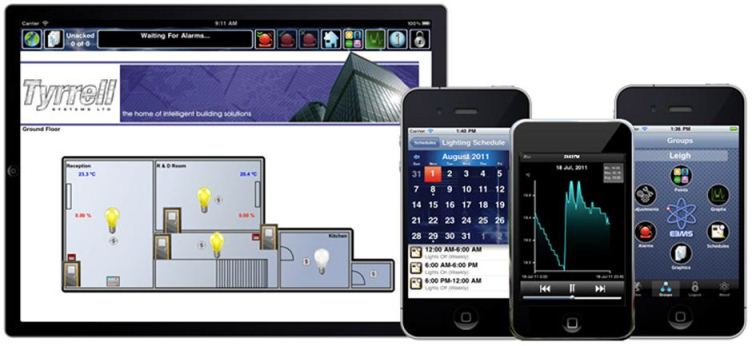|
June 2012
Article
AutomatedBuildings.com
|
[an error occurred while processing this directive]
(Click
Message to Learn More)
|
It's time we re-connected with our users
We need to stop thinking of our users as brown coat
wearing engineers looking after buildings but rather users as shop
assistants, administrators, managers and sales executives.
|

Ged Tyrrell
Founder/Managing Director
Tyrrell
Systems and
Tyrrell
Products Ltd |
In the last twenty
years of my career in building automation and
integration I've seen some huge changes in technology and how I use it.
Come to think of it; we all have…..
In the auto industry we've seen the eradication of carburetors, points
and ignition systems with moving parts. 20 years ago we were using map
books and now GPS can locate us to within a few feet of our exact
location. Digital cameras and post production software means we don’t
even have to wait 1hr to see the results. Boxes that record TV while
you are out, 24/7 online shopping and entertainment, dishwashers and
washing machines that can be programmed to come on and perform while
you sleep. And we’ve gone from reference books, through connecting to a
world wide web via a phone line and modem, to wireless internet access
during air travel...
Technology has become so intrinsic to the way we actually live now,
most users take it for granted; it operates ‘beneath the surface’,
focusing us on convenience, benefits and aesthetics rather than the
function of a machine or device. This convenience is simply not
possible with technology that has to 'boot-up' or whose batteries last
such a short time you may as well sit down because that device always
has to be plugged into a wall socket. Twenty years ago I did have a
mobile
phone but it was the size of a small handbag! Today my phone is not
really a phone but merely a piece of software, an “App”, on a powerful
portable computer that has an amazing touch screen and it even fits in
my pocket! The telephone is now just another App amongst many apps.
And it's with the advent of reliable portable computing in the form of
tablets and smartphones that the use of computers has shifted. Where
once a computer was a tool, even in the office sense, now more than
ever it is set to become a way of life; but whose life? In the recent
keynote address by Steve Fey, Tridium CEO at the 2012 Niagara summit,
he
showed us some staggering statistics (below) indicating that not only
are regular PC sales stagnating but they are being outstripped by
tablets such as the iPad and blatantly left behind by smartphones,
which are the mobile computer of today and certainly tomorrow.

So,
consider this groundbreaking growth for a minute and ask yourself a
few simple questions...who are these new users? What age demographic
are they? What are their expectations? How will they use these devices?
How patient will they be in their evaluation of any App or Web service?
My view
is this, and it may be an obvious one; they are not geeks,
engineers or technicians. No, they are in fact what I call normal
people. They are the lady who sits next to you on the bus or train you
take every morning. They are your spouses, children, partners, family
and friends. Most importantly, these new users are not “technical”
people, since we all know of the shrinking technical workforce in the
west. With specific focus on the next generation of 25-30s, we are
looking at a complete re-focusing on the benefits of technology rather
than the features, and that's a good thing in my view. Most users are
really not that interested in whether their satellite TV box runs Linux
or Windows, if it's got a hard disk or SSD! No, they are sharply
focused on how easy it is to use, how long it will record for and if
it's reliable. If it does all those things reasonably well, the
deciding factor will be how gorgeous it looks alongside their LED TV or
home cinema system; something Apple have clearly got to grips with in
the last 5 years.
Apps Versus Browser
I had a recent discussion with a very competent developer about how the
web can deliver everything that an App can, using various technologies
available now in HTML that weren’t possible even last year. I have to
admit, my mind was opened and I was pretty amazed at what you could do
with a browser yet look at these statistics below:
Here
again, we see technical possibilities losing ground. It’s not that
an App can do less, in fact it can do every bit as much as HTML5, so
what’s going on here? Well, if any of you are old enough to remember
the birth of video tapes and Betamax vs VHS, you will remember that
Betamax was technically superior in so many ways but users flocked to
VHS because more companies could make VHS players. This meant users
found it easier to make a purchase of a VHS machine based on cost,
aesthetics, benefits, features, etc. Betamax lost its edge and became
obsolete.
Apps
are easy to use and it’s as simple as that. If you have an App and
it says eBay, you know exactly what it’s for and with a single click
you are getting on with exactly what you wanted to do. Equally, with
different mobile platforms emerging, including iOS and numerous
iterations of Android, there are some particularly nice ease-of-use
features available to developers that can be implemented and tested
very simply, without having to wait for internet standards to make them
possible across all devices, which means you are getting a much more
tuned experience to not only what you want to do but the way the
creators want your experience to be like.
Our Industry Response

You may well be asking, what does that mean for all of us in the
engineering community, especially in our specialist fields of
facilities management, energy management and building automation and
integration? (I certainly hope you are asking this question.) It means
that we need to stop thinking of our users as brown coat
wearing engineers looking after buildings but rather users as shop
assistants, administrators, managers and sales executives. It is here
in these areas and with users like this that we are going to see the
growth of uptake in smart mobile devices; so when we think of how we
interact with these users, we need to stop thinking in terms of
graphics of boilers, roof top units, chillers and pipe work and more in
terms of thermometers, light switches, calendars and some form of
simple energy displays. These new users are more bothered about how
they can set their system to turn off next Friday because they are on
holiday than seeing fancy graphics indicating how many stages of
cooling are required to bring their store to a comfortable temperature.
These users want to know when they have a problem and who to ring, and
whether that last adjustment they made will cost them more money or
save some money when the energy bill comes. These are the users who are
not engineers; they want to click on an icon, get done exactly what
they want to do, without a manual or training course, and then get on
with the rest of their day. In a world where consumption of data is at
an all time high, data presentation is paramount. We need to enhance
the user experience and deliver the information and controls in a way
that makes sense straight away, and that provides simple feedback on
the affect any adjustments may have to comfort and energy consumption.
This
requires an altogether different approach to the one I have seen
even recently. As an engineering community, the response I am seeing to
all this new technology and possibilities is not a new way of
delivering the user’s interface but rather just a more polished and
swanky set of boiler, chiller and AHU graphics than we had in the early
1990’s. What have we really got to be proud of? Providing our users
with exactly the same experience we did in 16 colours but now in 16-bit
and maybe animated in flash or some other such technology our users are
equally uninterested in? It’s time, like our users, we focused on the
benefits, the meaning and the convenience if we as an engineering body
are to engage with this huge volume of mobile users.
That
may sound critical so let me be clear that I am not saying there
is not a place for articulate and stylized graphics of engineering
plant but the number of users for this type of presentation and
interface will continue to decrease, based on the type of device they
will use and, as I have already said, the kind of roles the users have.
If buildings, campuses or estates are large enough, they will of course
continue to have estates managers or facility managers and for these
technical types, re-vamped versions of the same flavors of experience
will of course be welcomed. But technically savvy people are not the
focus of either this article or the future of mobile computing.
eBMS/Mobile
Our product here at Tyrrell has had to be changed too. At first, our
development focused on delivering a fast feature-rich user experience
with zero engineering. Fast and easy access to schedules (time
control), points (temperatures), histories (graphs) and alarms
(problems). We did this in a way that could be deployed in as little as
10 minutes and we are really proud of these achievements.

However,
when we started to engage in particular with retailers and
middle to upper class homeowners we saw a real need for something new.
These users said to us things like, “excuse me, what is a ‘point’?
what’s a ‘history’?” and “Oh a schedule is the time clock, like my air
con at home?”. This was good feedback for us and it led us down a
completely new path where we wanted to provide the fastest way of
engineers setting up screens in logical groups, delivering content in a
beautiful style through automatic widgets that the end user will not
only relate to but find a joy to use.

We call
this Custom Views, but here at Tyrrell we believe this is the
way all users will want to engage with their building systems, whether
they are at home or at work, whether it is their core job or just
another additional element to their ever-expanding role.
eBMS/Mobile
is an App in the truest sense of the word and attempts to
deliver the benefits of being an App, as you would expect. By creating
a library of widgets that represent real life elements such as
temperature, blinds, lights, heating...the list goes on, we have
provided a fixed, yet flexible way of looking at the things that matter
most to the end user in their building. Equally, by holding libraries
of these widgets in the App, all we need to pass between the Building
Automation System and the App is pure data and pointers as to how to
display it, which again scores because we need the user experience to
be as fast as possible even on a slower cellular network.
[an error occurred while processing this directive]
Looking to the Future
This is a moment in time where many of life’s established technologies
potentially collude in our industry’s favour. The internet brings
complete connectivity; Apps bring the user the convenience, benefits
and aesthetics they desire; and the sheer proliferation of tablets and
smart phones means everyone has the most ideal user interface to
control their home heating or A/C time clock, their thermostat, their
external lighting time controller or sprinkler timer.
So with
this powerful control in every user’s hands, is it too much of
a stretch to see a jump to white goods being controlled by an App
rather than paying for fixed controls on these goods in our homes? I
don’t think so at all and if I was offered a washing machine that was
reduced by $50 by delivering its controls through an App I would
probably take it, mitigating any risk by buying an iPod Touch for the
home and leaving it on charge so my clothes could be washed regardless
of whether I left my phone or iPad at the office.
In
Building Automation and Systems Integration, this is exactly what
Tyrrell has done for the commercial space; linked things together with
a common user interface but the tools we used have been PC software and
now Web Based Software and Web Servers. So we already know the need and
desire to provide a common user interface exists. Now our industry
needs to do exactly the same thing all over again but to different
users, through different media, on different devices and presented in a
brand new way that engages with where these 100m new users are going to
come from.
In our engineering community, we need to fully wake up to the
day-to-day technology going on around us, and harness it, in order to
maximize our industry potential in an exciting new market.
About the Author
Ged
Tyrrell is the founder and managing director of Tyrrell Systems and
Tyrrell Products Ltd, based in the UK. Ged started in the industry at
17 and has been talking and walking programmable building automation
and integration systems since they first came into being in the late
80's. He not only has extensive knowledge on his subject matter but is
also passionate about it. It is this passion to make the world a better
place in his corner that has caused him to lead in first stepping out
as one of a handful of companies started in the late 90's just focussed
on building systems integration. In his latest venture, nearly
three years ago, Ged stepped out again, leading his team in the
development of a powerful and user friendly mobile App to re-connect
existing and a growing number of new users to control and monitor their
built environments, when no other company at that time was showing any
interest.
footer
[an error occurred while processing this directive]
[Click Banner To Learn More]
[Home Page] [The
Automator] [About] [Subscribe
] [Contact
Us]
